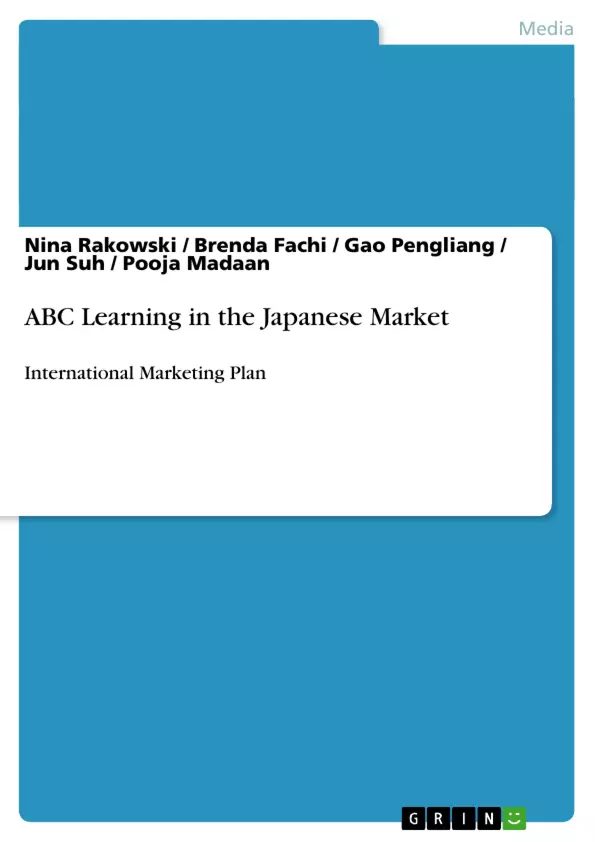This paper is a detailed international marketing plan for ABC Learning, the Australian child care operator.
The purpose of this international marketing plan is to analyse the viability of opening an ABC child care centre in Japan. Japan has a demand for child care centres and low barriers to entry. A detailed analysis was prepared for the child care industry in Japan as well as for the home market Australia in order for comparisons to be made.
This paper provides a situation analysis about the Japanese environment and a SWOT analysis followed by various models and research. This report will recommend marketing strategies and an estimated planned budget for ABC Learning in order to achieve marketing objectives. Finally, implementation and control will be provided in form of an action plan.
After comprehensive analysis, the recommendation is for ABC learning not to enter the Japanese market at this stage. Reasons for this decision will be discussed throughout the report as well as in the conclusion.
The scope of study was limited to the operations and activities of ABC learning in Australia, based on publicly available information.
Inhaltsverzeichnis (Table of Contents)
- Executive summary
- Table of Figures and Tables
- 2.0 Company Analysis
- 2.1 About ABC Learning
- 2.2 Product Range
- 2.3 Market Position
- 2.4 Porters Diamond model on child care industry Australia
- 3.0 Market Analysis of Japan
- 3.1 Environmental Climate
- 3.2.1 Nature of Demand
- 3.2.2 Cost Structure of the Industry
- 3.3 Regulatory Environment
- 3.4 Competitor Analysis
- 3.5 Situation Analysis
- 3.7 Porters Diamond Model on Child Care Industry Japan
- 4.0 SWOT Analysis
- 5.0 OBJECTIVES
- 5.1 Market Objectives
- 5.2 The Recommended Marketing Strategy
- 5.2.1 Market Entry Evaluation
- 5.2.2 Recommended Strategy
- 6.0 Marketing Mix Strategies and Tactics
- 7.0 Planning Budget
- 7.1 Planning Assumptions
- 8.0 Implementation and Control
- 9.0 Recommendation
- REFERENCES
- Appendix
- Overview allocations of tasks for project
Zielsetzung und Themenschwerpunkte (Objectives and Key Themes)
This international marketing plan aims to analyze the feasibility of establishing an ABC Learning childcare center in Japan. The plan compares the child care industry in Japan with that of ABC Learning's home market, Australia. It examines the Japanese market environment, conducts a SWOT analysis, and explores various models and research. The paper then proposes marketing strategies, estimates a budget, and outlines an action plan for implementation and control. Here are some key themes explored in the paper:- Analysis of the Japanese child care market
- Comparison of the child care industry in Japan and Australia
- Assessment of the viability of ABC Learning's entry into the Japanese market
- Development of a comprehensive marketing plan for ABC Learning in Japan
- Evaluation of different market entry modes
Zusammenfassung der Kapitel (Chapter Summaries)
- The executive summary provides a concise overview of the paper's purpose, methodology, and key findings. It states that the paper will recommend whether or not ABC Learning should enter the Japanese market.
- The company analysis section introduces ABC Learning, its product range, market position, and strategic approach to international expansion. It uses Porter's Diamond model to analyze the Australian child care industry.
- The market analysis of Japan section explores the environmental climate, nature of demand, cost structure, regulatory environment, competitor analysis, and situation analysis. It also utilizes Porter's Diamond model to analyze the Japanese child care industry.
- The SWOT analysis section outlines the strengths, weaknesses, opportunities, and threats for ABC Learning entering the Japanese market.
- The objectives section defines market objectives and details the recommended marketing strategy, including market entry evaluation and the chosen entry mode.
- The marketing mix strategies and tactics section outlines various marketing strategies and tactics, including product, price, place, and promotion strategies.
- The planning budget section discusses planning assumptions and provides a detailed breakdown of the projected budget.
- The implementation and control section outlines an action plan for the implementation of the proposed marketing strategy and monitoring its effectiveness.
Schlüsselwörter (Keywords)
This paper focuses on the international marketing of childcare services, specifically examining the viability of ABC Learning's entry into the Japanese market. It explores various concepts, including market analysis, SWOT analysis, competitor analysis, market entry strategies, and marketing mix strategies. The paper also utilizes frameworks such as Porter's Diamond model and the Five Forces model to analyze the competitive landscape of the child care industry in both Australia and Japan.- Quote paper
- Nina Rakowski (Author), Brenda Fachi (Author), Gao Pengliang (Author), Jun Suh (Author), Pooja Madaan (Author), 2008, ABC Learning in the Japanese Market, Munich, GRIN Verlag, https://www.grin.com/document/135655



